Note: This article was originally published in MASS Research Review. It’s a review of a recent study: Different Load Intensity Transition Schemes to Avoid Plateau and No-Response in Lean Body Mass Gain in Postmenopausal Women by Carneiro et al.
Key Points
- Healthy, postmenopausal women completed 24 weeks of lower-body resistance training, consisting of 12 weeks of moderate-load training (sets of 8-12 reps), and 12 weeks of low-load training (sets of 27-31 reps), performed in a randomized order.
- Both orders of training sequencing produced similar increases in lean soft tissue mass (15). Furthermore, average rates of lean mass accrual were similar in the first and second 12 weeks of training.
- The present study employed a crossover design and reported individual subject data. Such data allows us to probe questions related to optimizing relative training intensity for individuals, and the reliability of classifying people as “high responders” and “low responders” to resistance training.
When you reach a plateau in your training – you keep training hard, but further muscle growth and strength gains are hard to come by – how can you break through that plateau? Potential options range from fun (dreamer bulk, baby), to practical-but-boring (try to sleep more and manage stress better), to illegal-in-many-jurisdictions (up the dose, lift the most). One surprisingly controversial option, however, is to make significant adjustments to your training program. Some will argue that changing your training program is only logical, since your current program isn’t producing the results you want. Other people will accuse you of “program hopping,” or say you have “training ADHD,” and that you just need to commit harder to your current training approach (especially if it previously produced solid results for you).
So, what does the research say? Can you get the gains rolling again by changing your training approach, or is doing so a waste of time? Surprisingly, there’s not a ton of research on the topic. However, a recent study (1) purports to demonstrate that switching to a completely different relative training intensity (percentage of 1RM) can help you avoid a plateau. In the present study, subjects completed 24 weeks of training. Half of the subjects did 12 weeks of low-load training (starting with 30% of 1RM, and performing sets of 27-31 reps), followed by 12 weeks of moderate-load training (starting with 80% of 1RM, and performing sets of 8-12 reps). The other half did 12 weeks of moderate-load training first, followed by 12 weeks of low-load training. The researchers found that, in contrast with other research (which suggests that hypertrophy slows down dramatically after about three months of training), lean mass gains occurred at the same rate during both 12-week blocks of training. So, are wholesale changes in training intensity the holy grail for avoiding or breaking through plateaus? Read on to find out. I’m not fully convinced, but the design and thorough data reporting in the present study allow us to probe several interesting and practical questions related to individual responses to different training styles.
Purpose and Hypotheses
Purpose
The primary purpose of this study was to compare the effects of low-load training followed by moderate-load training, versus moderate-load training followed by low-load training, for the purpose of supporting lean mass accretion. The secondary purpose was to see how changing training intensity would affect responsiveness to resistance training.
Hypotheses
No hypotheses were directly stated.
Subjects and Methods
Subjects
24 postmenopausal women participated in the present study. All subjects were at least 50 years old, had not menstruated in the preceding 12 months, did not use hormone replacement therapy, were free of significant cardiometabolic or orthopedic issues, and had not participated in regular physical activity more than once per week in the six months preceding the study. Subject characteristics can be seen in Table 1.
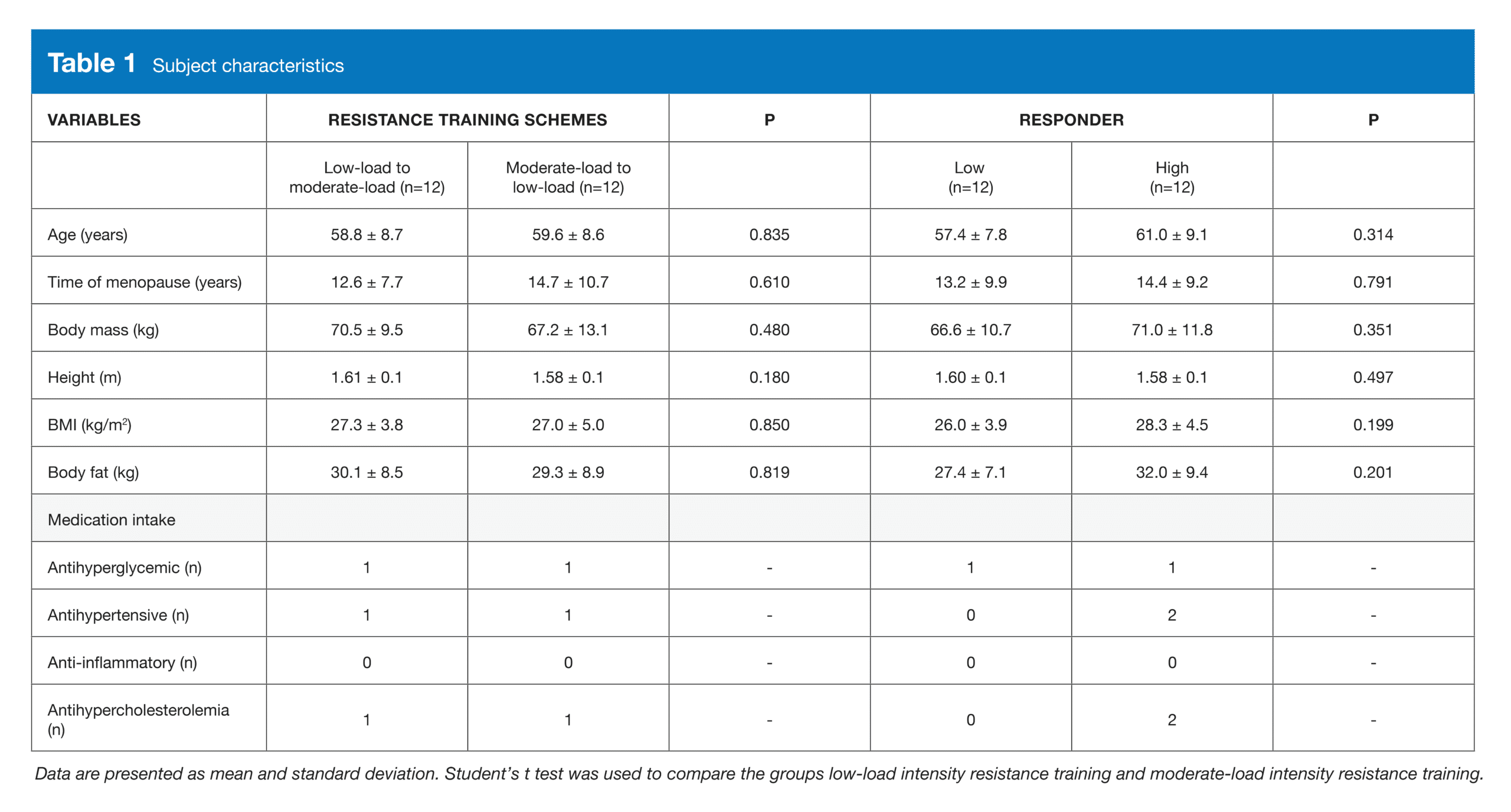
Experimental Design
This study took place over 28 weeks, including a 24-week training intervention. During the first week, subjects performed three familiarization sessions to get acquainted with the exercises used in the study (leg press, knee extensions, leg curls, and calf raises). During the second week, subjects completed 1RM tests to determine their initial training loads, and researchers collected the subjects’ basic anthropometric data (height, weight, and body fat), along with assessing thigh lean soft tissue mass (via DXA). From weeks 3-14, subjects completed twelve weeks of resistance training. During week 15, researchers reassessed the subjects’ thigh lean soft tissue mass and 1RM strength for all four training exercises. From weeks 16-27, subjects completed 12 more weeks of resistance training. Finally, thigh lean soft tissue mass was reassessed in week 28. Post-training 1RM strength was not assessed (or, at minimum, it wasn’t reported).
All subjects completed two different resistance training programs. Both programs consisted of leg press, knee extensions, leg curls, and calf raises, all performed for three sets (2) with 90 seconds of rest between sets. All sets were performed “until, or close to, voluntary concentric failure,” according to the study (though, as far as I can tell, proximity to failure wasn’t strictly controlled or directly quantified). The two programs only differed in terms of training load. The moderate-load program started with subjects at 80% of their 1RM, with the aim of completing 8-12 reps per set, while the low-load program started with subjects at 30% of 1RM, with the aim of completing 27-31 reps per set. When subjects completed at least 12 reps during the first set of an exercise on the moderate-load program, or 31 reps during the first set of an exercise on the low-load program, training loads were increased by 5-10% for their next training session. Half of the subjects were randomly assigned to complete the moderate-load program first, while the other half completed the low-load program first. After the first 12 weeks of training and the mid-study strength and lean mass assessments, subjects switched training programs for the second half of the study. So, half of the subjects completed 12 weeks of moderate-load training followed by 12 weeks of low-load training, and half of the subjects completed 12 weeks of low-load training followed by 12 weeks of moderate-load training.
The researchers were primarily interested in two outcomes: progression of training loads (absolute training loads, total reps completed, and volume load), and accrual of thigh lean soft tissue mass. The lean mass data was also analyzed in two different ways. First, the researchers compared the two training approaches (low-load followed by moderate-load training, versus moderate-load followed by low-load training) to see if either loading scheme produced better outcomes. Second, the researchers split apart “high responders” and “low responders” to resistance training following the first 12 weeks of training, using a median split (i.e., the 50% of subjects with the largest lean mass gains during the first 12 weeks of training were deemed to be high responders, and the 50% of subjects with the smallest lean mass gains were deemed to be low responders). They were interested in assessing whether training responsiveness during the first 12 weeks of training was predictive of responsiveness during the last 12 weeks of training, and whether changing relative training intensities would improve overall training responsiveness in the initial low responders.
Findings
Table 2 shows the training load progression observed following the two training approaches.
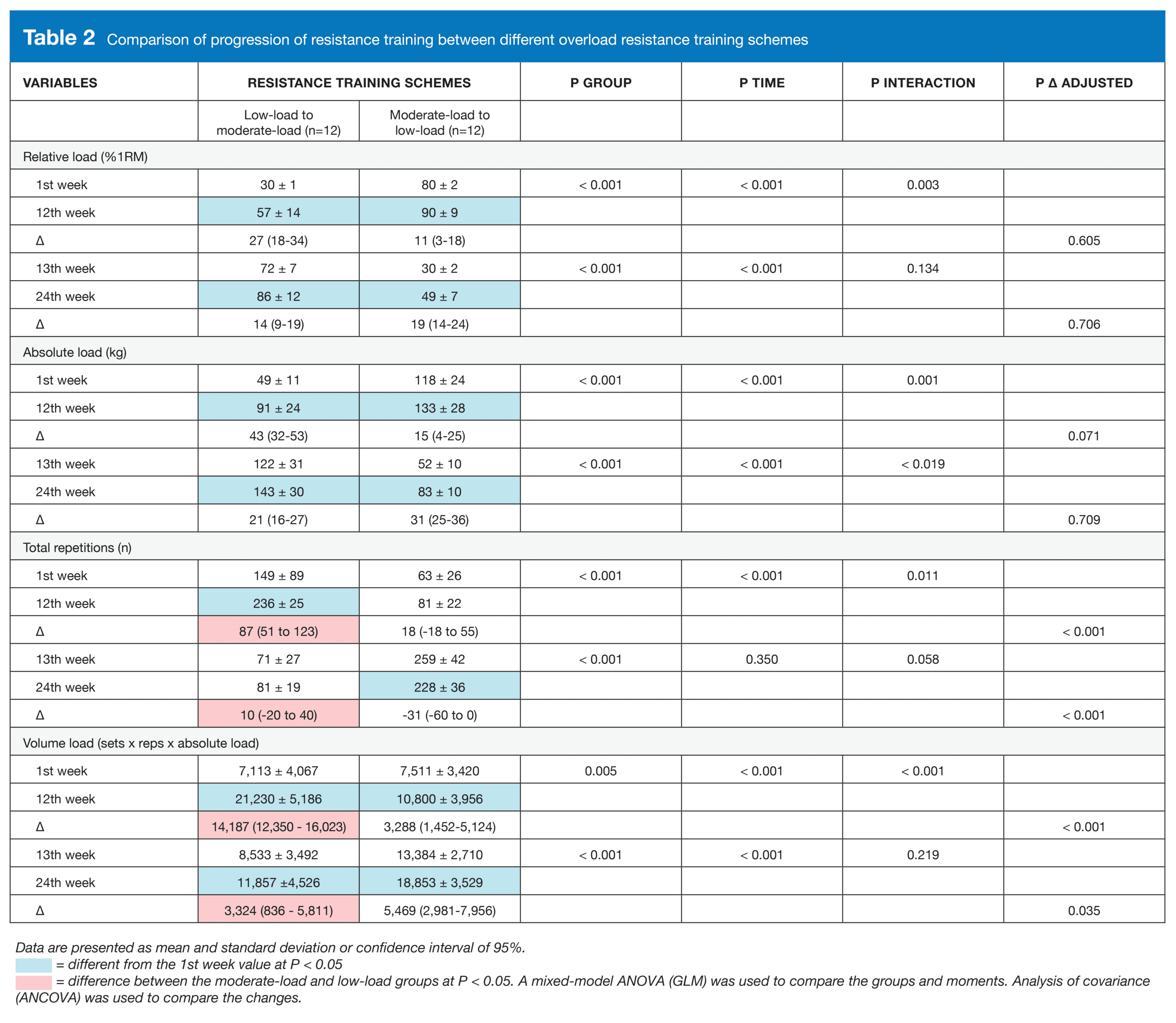
Overall, both of the programs worked, insofar as absolute load and volume load increased over time. I’m not too interested in the direct comparisons between the two programs, though. According to the results table, the low-load program looks like it was more effective, but I think that’s an artifact of the way initial training loads were assigned. Once people get a bit of training experience (i.e., once someone establishes decent strength endurance), they can generally complete considerably more than 27-31 reps at 30% of 1RM, whereas 8-12 reps at 80% of 1RM is pretty challenging for most folks. So, by using 30% of 1RM as the initial intensity for the low-load training protocol, I think the researchers simply (inadvertently) stacked the deck for low-load training to appear to allow for greater progression of training loads. Regardless, it’s clear that both programs effectively promoted improvements in strength (demonstrated by absolute training loads increasing in both programs) and work capacity (demonstrated by total volume load increasing in both programs).
Table 3 shows the changes in lean mass over time.
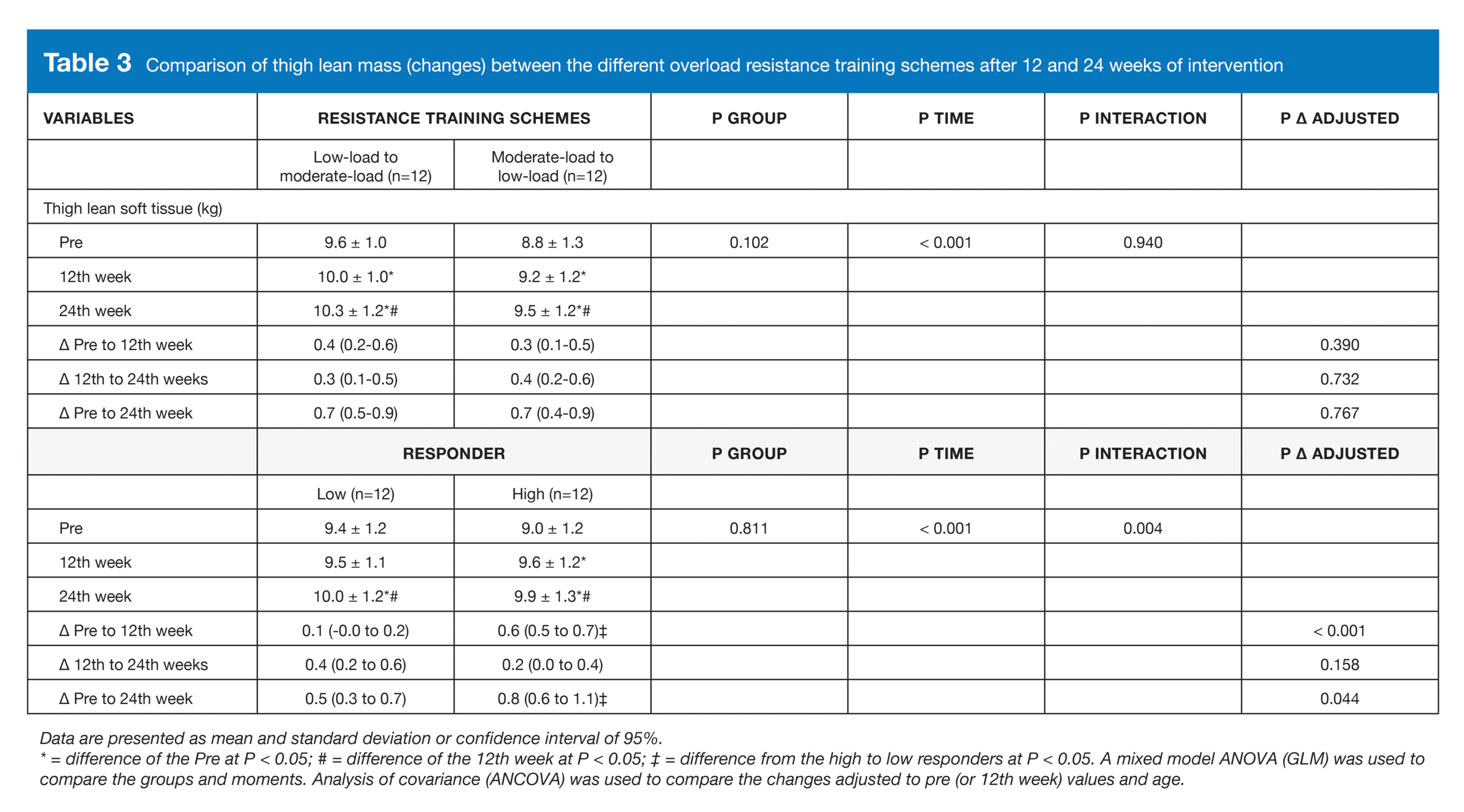
Both protocols were similarly effective at promoting increases in thigh lean soft tissue mass. In the group completing low-load training followed by moderate-load training, subjects gained an average of 0.4kg of lean mass in the first 12 weeks of training, and 0.3kg of lean mass in the last 12 weeks of training, for a net increase of 0.7kg. In the group completing moderate-load training followed by low-load training, subjects gained an average of 0.3kg of lean mass in the first 12 weeks of training, and 0.4kg of lean mass in the last 12 weeks of training, also for a net increase of 0.7kg.
However, an interesting pattern emerges when we look at the thigh lean soft tissue mass accrual of “low responders” versus the “high responders.” During the first 12 weeks of training, which were used to determine responsiveness, the low responders gained very little thigh lean soft tissue mass (0.1kg), while the high responders gained 0.6kg. However, during the last 12 weeks of training, the low responders actually gained (nominally) more thigh lean soft tissue mass (0.4kg) than the high responders (0.2kg; p = 0.16). The high responders did still wind up gaining significantly more thigh lean soft tissue mass over the entire 24 weeks of training (0.8kg versus 0.5kg; p = 0.044), but the difference between high and low responders narrowed considerably. You can see individual subject data illustrating the different time course of lean mass gains in Figure 1.
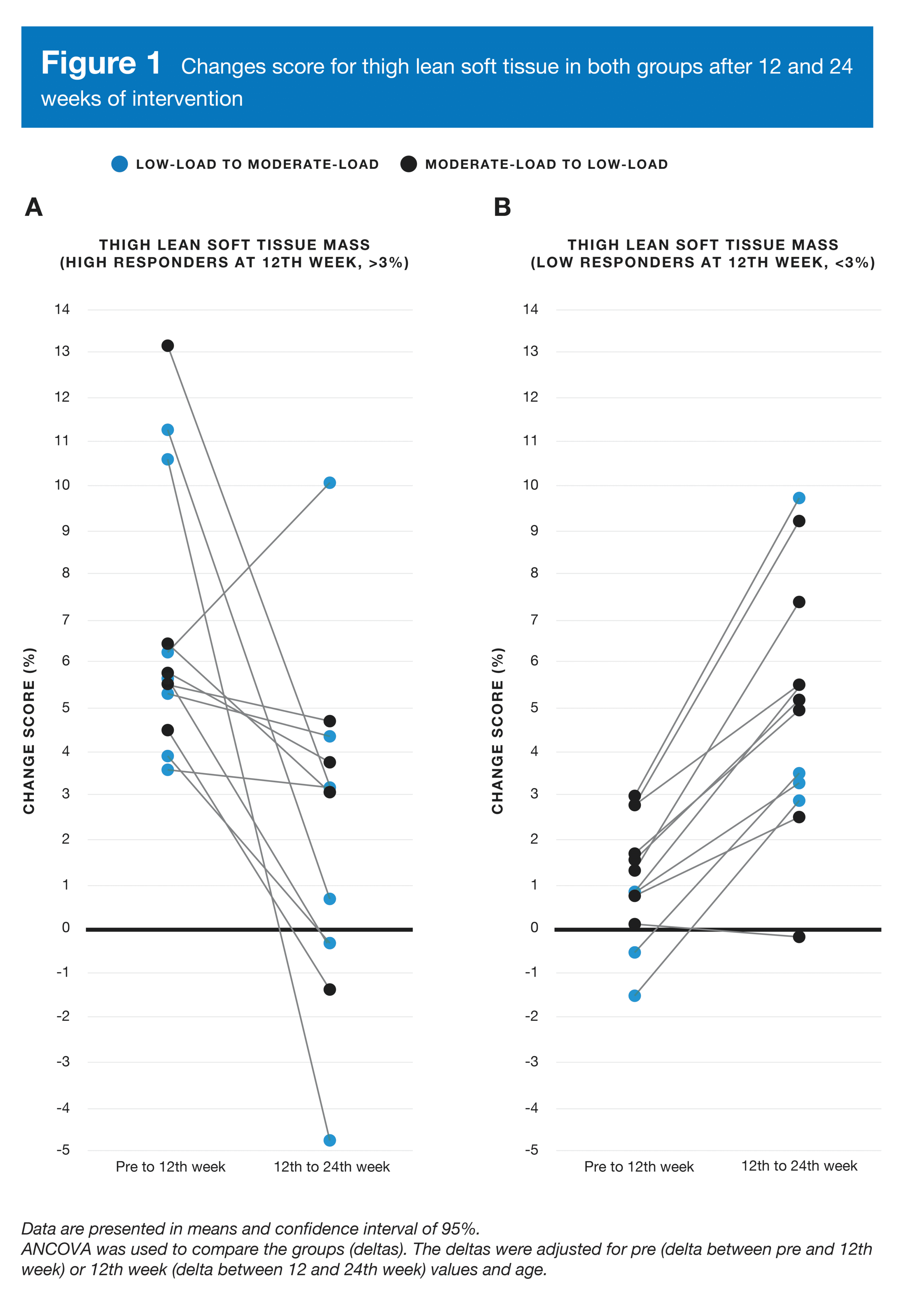
Criticisms and Statistical Musings
My only significant criticism of the present study was the decision to analyze high versus low responsiveness to training using a median split. Ultimately, if you’re interested in analyzing whether training responses during the first 12 weeks of training are predictive of training responses during the last 12 weeks of training, regression analysis is far more informative (3). With a median split, you flatten out differences between individuals, such that the worst responder is treated the same as a subject in the 49th percentile, and the best responder is treated the same as a subject in the 51st percentile. Similarly, subjects near the median who experienced very similar responses during the first 12 weeks of training are treated as if they’re completely different.
I extracted the data in Figure 1 using WebPlotDigitizer, and wanted to see the relationship between relative increases in thigh lean soft tissue mass in the first 12 weeks, versus increases in the last 12 weeks of training. You can see the results in Figure 2. Each data point represents a single subject; their x-axis coordinate tells you their relative increases in thigh lean soft tissue mass during the first 12 weeks of training, and their y-axis coordinate tells you their relative increase in thigh lean soft tissue mass during the last 12 weeks of training.
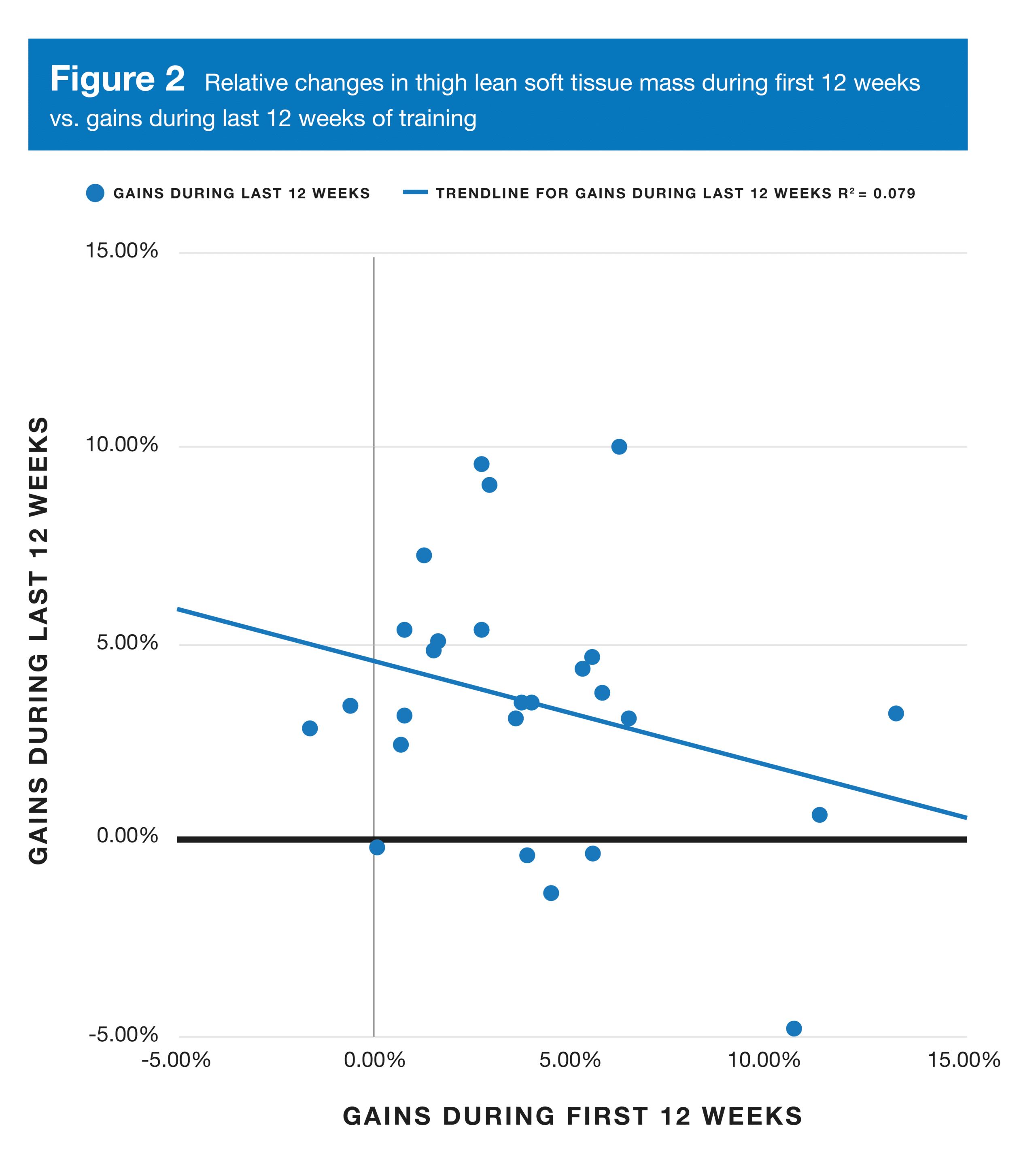
As you can see, there wasn’t much of a relationship between hypertrophy during the first phase of training and hypertrophy during the second phase of training (r = -0.28; p = 0.18). This scatterplot is more informative than the group-level analysis comparing mean responses at the bottom of Table 3. And, while Figure 1 displays all of the same information seen in this scatterplot, it’s still harder to directly interpret since the low responders and high responders are split out onto different axes. However, when we treat training responsiveness as a continuous variable (rather than a binary variable), we can more clearly see that lean mass accretion during the first phase of training was poorly predictive of lean mass accretion during the second phase of training.
Interpretation
This is a study I’ve wanted to see for a long time. My anecdotal observation is that some people simply seem to respond better to heavier training, and some people simply seem to respond better to lighter training. However, the controlled evidence to back up that observation was shaky at best. There were two studies that could be used to make that case, but both of them had some obvious issues. First, a study by Beaven and colleagues ran subjects through four different training protocols (3 sets of 5 reps at 85% of 1RM, 4 sets of 10 reps at 70% of 1RM, 5 sets of 15 reps at 55% of 1RM, and 4 sets of 5 reps at 40% of 1RM), and tested the subjects’ acute salivary testosterone and cortisol responses (4). Subjects completed three weeks of training with the protocol that elicited the largest increase in testosterone:cortisol ratio, and three weeks with the protocol that elicited the smallest increase (or largest decrease) in testosterone:cortisol ratio. The researchers found that subjects experienced a larger increase in body mass during the three weeks when they performed the protocol that elicited the largest increase in testosterone:cortisol ratio. However, the limitations in that study should be obvious. The training intervention was really short (just three weeks with each protocol), and it’s a stretch to assume that increases in body mass necessarily equal increases in muscle mass. Another study by Jones and colleagues assigned subjects to training protocols that were supposed to be compatible with their genetics or incompatible with their genetics, using a proprietary algorithm (5). The subjects completed strength endurance-based training or power-based training. Overall, subjects experienced larger improvements in several measures of performance when training in a manner that was compatible with their genetics. However, that study contained a clear conflict of interest – the algorithm used to assign subjects to different groups isn’t publicly available, and an employee of the company that developed the algorithm was one of the authors of the study. Now, studies with conflicts of interest shouldn’t be discounted out of hand, but it helps for results to be independently validated by other research groups that lack those same conflicts of interest. To the best of my knowledge, the results of the study by Jones and colleagues haven’t been replicated.
Furthermore, as we’ve covered in MASS before, there’s quite a bit of evidence that many training variables have a much smaller influence on hypertrophy than innate differences in trainability. For example, a study by Hammarström and colleagues (reviewed in MASS; 6) investigated the effects of training volume (total sets performed) on quad growth. Subjects completed six weekly sets of quad work with one leg, and 18 weekly sets with another leg. The researchers found that higher training volumes tended to result in more muscle growth, but that innate differences in trainability influenced hypertrophy far more than training volume. In other words, someone who experiences a lot of muscle growth with high training volumes will probably experience a lot of muscle growth with lower training volumes, and someone who doesn’t experience much growth with low training volumes probably won’t experience that much more growth with higher training volumes. A study by Damas and colleagues (7 – also reviewed in MASS) had similar findings when testing the effect of keeping training variables consistent session-to-session versus varying load, rest intervals, the muscle actions performed, and training volume. Subjects who experienced a lot of growth following varied training were also likely to experience a lot of growth with more consistent training, and subjects who experienced little growth with varied training were unlikely to experience way more or way less growth with consistent training (Figure 3).
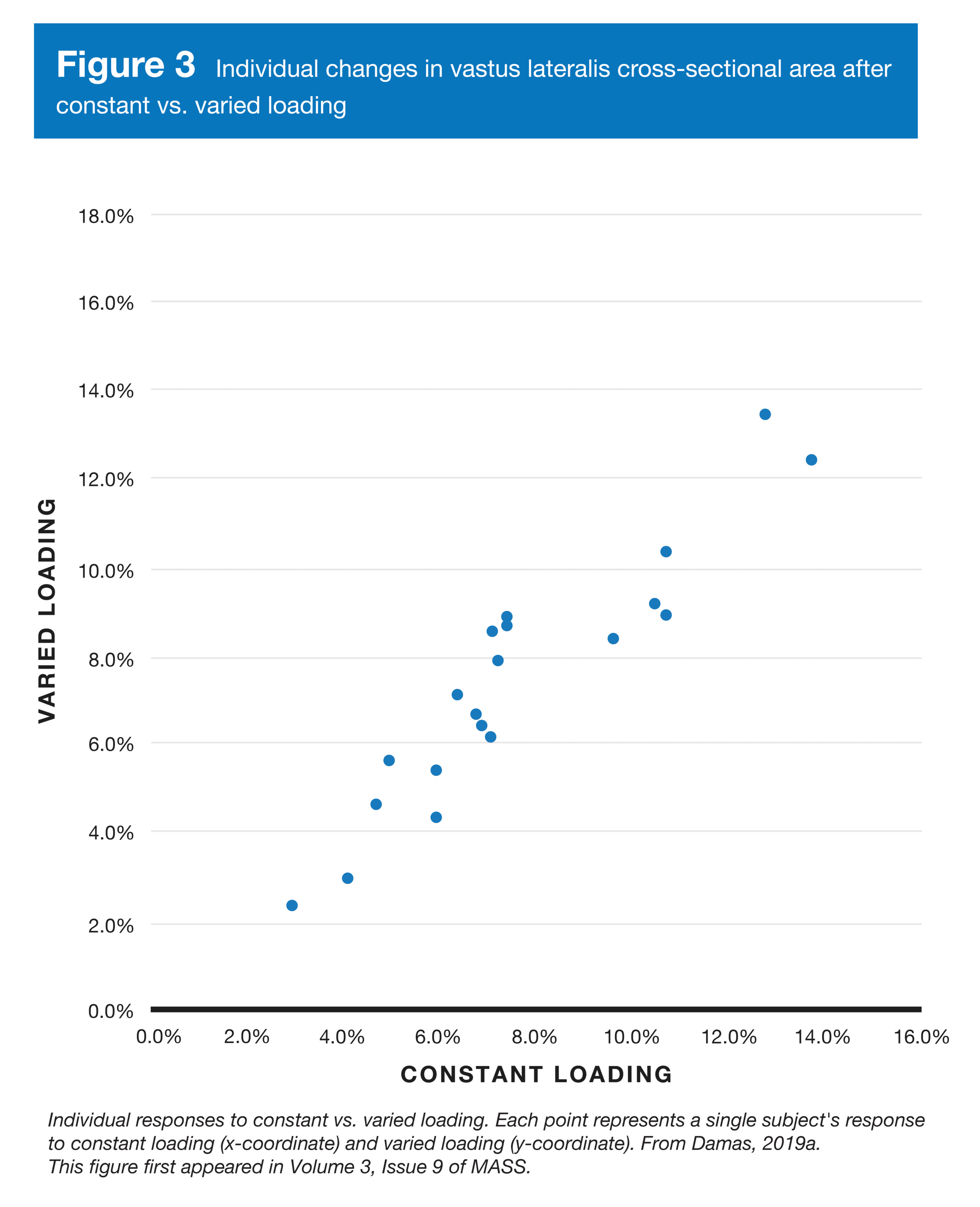
Thus far, I’ve painted a pretty bleak picture for folks who want to optimize their training. Maybe manipulating training variables can improve your results slightly, but the vast majority of your results are merely dictated by your innate trainability. However, there’s a notable exception to this rule. Another study by Damas and colleagues tested the effects of different training frequencies (frequencies of 2, 3, and 5 times per week), using a within-subject unilateral design (8). Each training session employed the same volume, such that a frequency of five times per week coincided with 2.5-times more volume than a frequency of 2 times per week. In that study, innate trainability didn’t seem to matter quite as much. Some subjects grew a ton with higher volumes and frequencies (and not very much with lower volumes and frequencies), and some grew a ton with lower volumes and frequencies (and not very much with higher volumes and frequencies). So, while volume itself seems to matter less than innate trainability when training frequencies are the same (6), a single individual can achieve dramatically different results – either better results or worse results – when pairing higher or lower training volumes with higher or lower training frequencies (Figure 4).
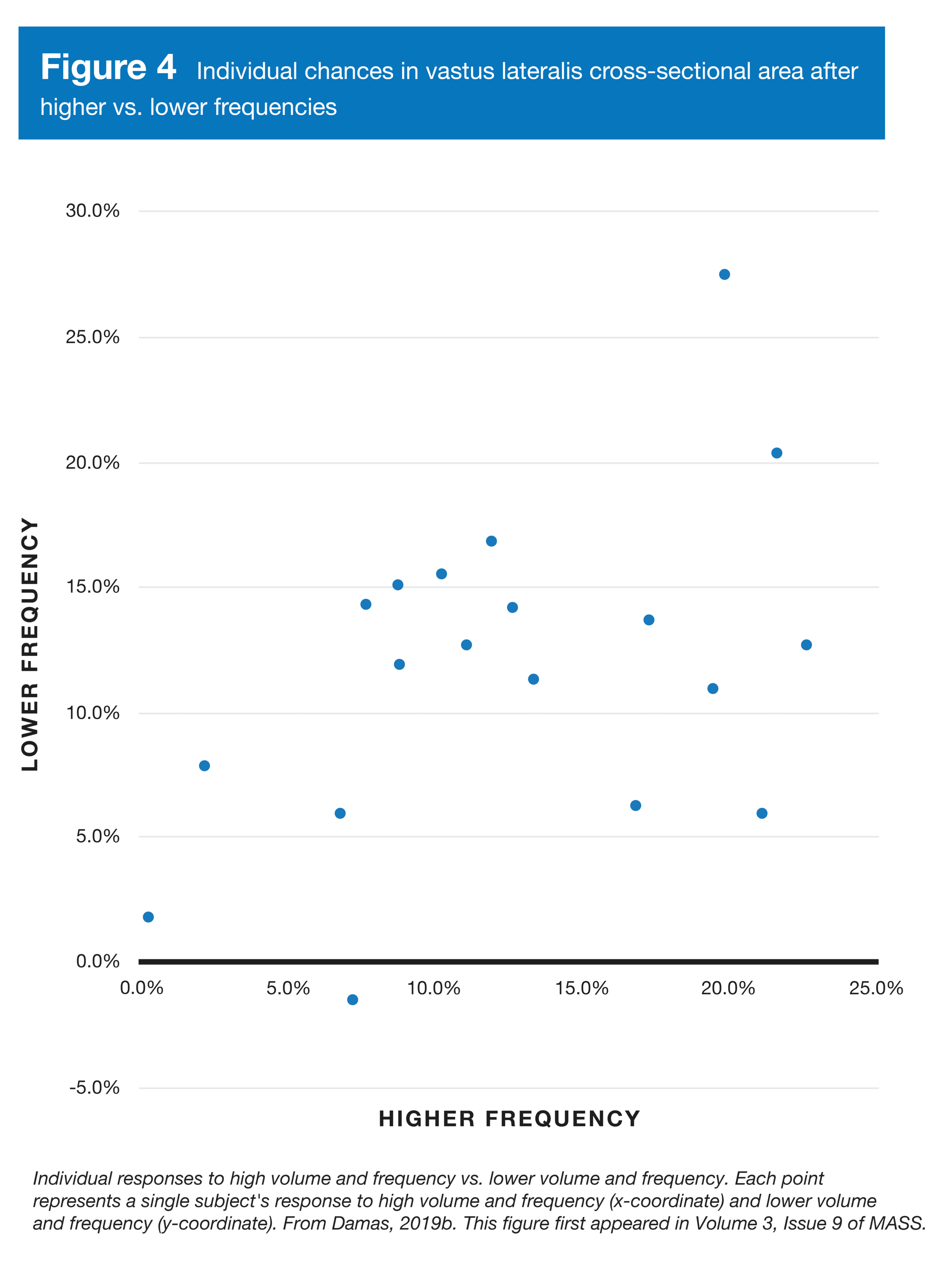
I’ve long suspected that relative training intensity was another variable that can influence individual results. Some people really seem to respond well to heavier training, while other people swear by low-load, high-rep training. However, while some studies employing within-subject unilateral designs have tested the effects of different relative training intensities (9 – MASS review; 10 – MASS review), they haven’t reported individual subject data, which would be necessary to see if individual results do, in fact, significantly differ when training at different relative intensities.
The present study helps fill that gap (1). While it didn’t employ a within-subject unilateral design, the subjects did all complete a relatively long period of both low-load training and moderate-load training. It’s possible that the crossover design may have introduced some sequencing effects (i.e., perhaps subjects respond differently to one training style after a period of training with a different training style), but that seems unlikely, since group-level results of both moderate-load and low-load training seemed unaffected by which training style was performed first. In other words, low-load training seemed similarly effective when it came before moderate-load training and when it followed moderate-load training (and the same was true with moderate-load training, preceding or following a period of low-load training).
Referring back to Figure 2, it doesn’t just show individual results during the first twelve weeks of training versus the last twelve weeks of training. Since subjects changed training styles at the midpoint of the study, it also shows individual results following moderate-load training versus low-load training. Figure 5 displays the same data in a slightly different format (similar to Figure 1), showing that individual hypertrophy responses to one loading scheme have virtually no bearing on individual hypertrophy responses to the other loading scheme.
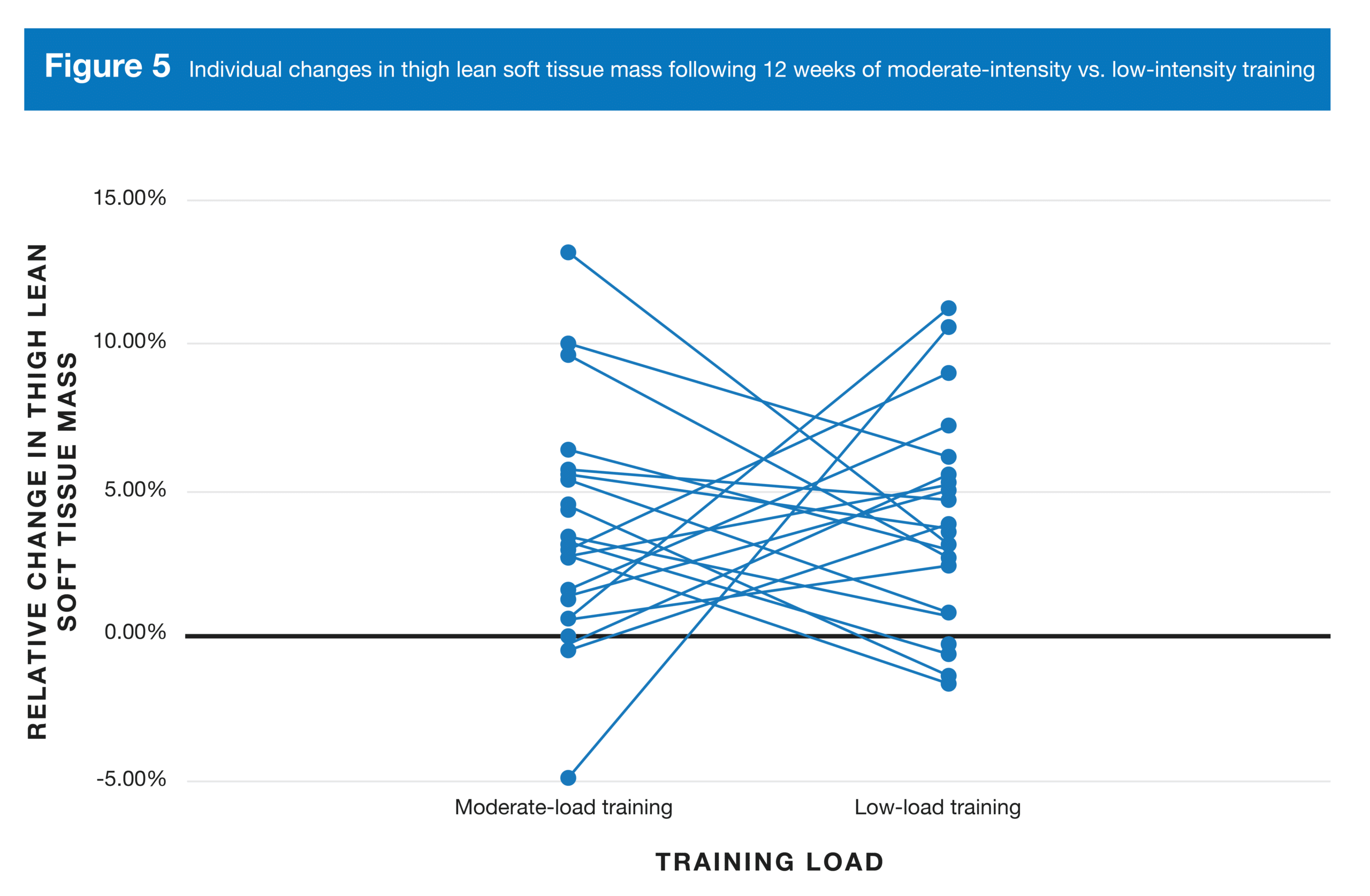
This is an exciting finding, because it presents us with another clear option to try when “normal” training isn’t producing particularly notable results in a particular trainee. Most hypertrophy-focused training employs a moderate set volume (5-10 sets per muscle group per session), a moderate intensity (loads that let you complete 6-15 reps per set), and a low-to-moderate frequency (training most muscle groups 1-3 times per week). For most people, that produces pretty good results. However, if that doesn’t work particularly well for someone, there aren’t a ton of great troubleshooting recommendations that we know are likely to produce substantially different outcomes. There are some things that might, on average, produce slightly better results (i.e., increasing training volume; 6). There are also plenty of options for which within-subject variability is unquantified. For example, we know that training to failure and stopping a few reps shy of failure tend to produce similar muscle growth, on average, but we don’t know if they tend to produce substantially different results within a single trainee. If stopping a few reps shy of failure doesn’t result in much growth for you, are you likely to achieve meaningfully different results if you start training to failure? We don’t know for sure. Ideally, we’d have a long list of training variables that are known to result in large within-individual differences in muscle growth. However, until now, the Damas study which tested the effects of different volumes and frequencies provided us with the only known set of variables that produce large within-subject differences in muscle growth (8). So, if “normal” hypertrophy training wasn’t working, you could advise someone to double (or halve) their weekly training volume and per-muscle training frequency, and be reasonably confident that such a recommendation would produce substantially different results…but that’s a pretty dramatic recommendation. The present study suggests that a less dramatic recommendation could also be prudent: if sets of 10 aren’t cutting it for you, give sets of 30 a shot instead.
Before wrapping up, I want to tie up a few loose ends.
First, the authors of the present study suggest that their findings demonstrate that shifting from moderate- to low-intensity training or from low- to moderate-intensity training prevents (or at least delays) plateaus, and preserves training responsiveness over a longer period of time (1). Some evidence suggests that hypertrophy tends to slow down quite a bit after about 12 weeks of training (11), but subjects in the present study grew just as much during the last 12 weeks of training as the first 12 weeks of training. However, I’m not sure I agree with the authors’ interpretation of their results. It appears to me that changing training intensities only preserved the same average rate of progress because it dramatically improved the results of the subjects who experienced minimal muscle growth during the first 12 weeks of training. If anything, changing training intensities may have hindered the growth of subjects who experienced substantial muscle growth during the first 12 weeks of training. In other words, average results were similar during both 12-week blocks of training because most of the subjects completed one block of training they responded well to, and one block of training they didn’t respond well to; for about half of the subjects, the first block of training was the effective block, and for the other half of the subjects, the second block of training was the effective block. I think a better takeaway is that you shouldn’t necessarily change training intensity every so often for its own sake; rather, you should change training intensity if it becomes clear that a particular relative training intensity isn’t producing the results you want, but you should stick with a particular relative training intensity as long as it’s still working for you.
Second, this study could be interpreted as a study comparing linear periodization versus reverse linear periodization. As we discussed recently, it appears that linear and reverse linear periodization result in similar muscle growth, on average (12). The present study adds to that body of literature.
Third, the present study beautifully illustrates a pitfall that’s pretty common in the evidence-based fitness community. When you consume a lot of scientific literature, it’s easy to fixate on average results, because most statistical techniques are focused on testing for differences between means. However, averages often cover up a lot of underlying variability. For example, imagine someone asks you, “should I give low-load training a shot? I’ve been doing sets of 8-12 for the past six months, and I haven’t seen any results.” It might be tempting to answer, “don’t waste your time. Low-load and moderate-load training produce similar muscle growth, so if moderate-load training isn’t working for you, low-load training probably won’t either.” While that answer would be based on a kernel of truth (13), it would still be a pretty bad answer. “Thing A and Thing B produce similar results, on average,” is not the same as, “Thing A and Thing B produce similar results for all (or even most) individuals.” When fielding questions or evaluating anecdotes, it’s important to keep that distinction in mind.
Fourth, the present study helps illustrate one of my problems with the concept of identifying high versus low responders to resistance training. Ultimately, if someone is identified as a “high responder,” that just means they responded particularly well to one particular training program. Similarly, if someone is identified as a “low responder,” that just means they responded particularly poorly to a particular training program. Over the course of your training career, I’m sure you can think of periods where you were making rapid progress, and periods when your results were stagnating (or even regressing). If a researcher took a snapshot of your training at various points in your lifting career, they might identify you as a high responder sometimes, and a low responder other times. Thus, the label doesn’t seem particularly meaningful, because your innate ability to respond to training didn’t change – you were the same biological organism the whole time (I assume). In the present study, if the median split technique to identify high versus low responders was repeated after the subjects completed all 24 weeks of training, a full third of the subjects would have switched groups (Table 4). Four of the “high responders” (within the top 50% of responders) after 12 weeks of training would have been categorized as “low responders” (within the bottom 50% of responders) after 24 weeks of training; similarly, four of the low responders after 12 weeks of training would have been categorized as high responders after 24 weeks of training. After completing a single training program, we really don’t know if a particular individual is a high or low responder to training in a general sense. Furthermore, it’s worth noting that virtually all subjects ended up accruing a substantial amount of lean mass over the course of the study. It’s not uncommon for studies to report that approximately 1/3rd of subjects are “nonresponders” – people who either lose muscle, or experience gains that fall below the limits of reliable detectability. In the present study, 7 out of 24 subjects (29%) either had reductions in lean mass, or increases smaller than 1.3% (the lower end of reliable detectability for the DXA used for lean mass measurements) after the first 12 weeks of training. However, after giving low responders the opportunity to try a new training program for an additional 12 weeks, only two subjects (8%) would have been classified as nonresponders after all 24 weeks of training. With all of that in mind, I think most classifications of “high responders,” “low responders,” and “nonresponders” are essentially bunk. At minimum, there’s not great evidence that such a classification is particularly persistent or reliable, and the present study provides evidence that such classifications are not persistent or reliable.
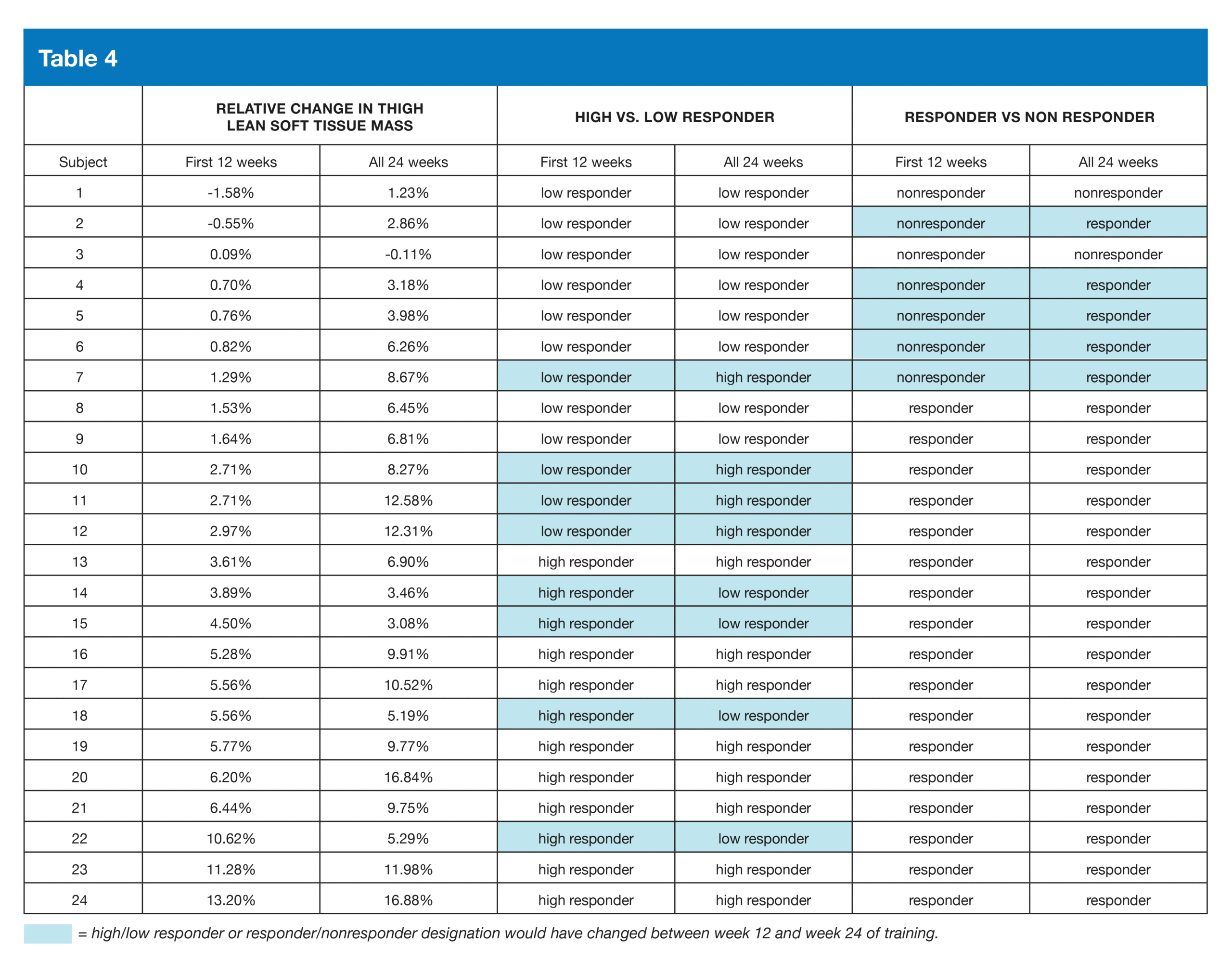
Finally, just to address a potential criticism of this article, I’m sure some readers may be concerned that the subjects of the present study were untrained postmenopausal women. First, I don’t think that’s inherently a limitation; postmenopausal women do exist, after all, and some of them read Stronger By Science. So, even if the results of this study don’t generalize beyond that population, the results are certainly still valuable. Second, and more importantly, I do suspect that the results of the present study will generalize to other populations. In studies on older adults, I’m primarily concerned about three things when assessing whether the results are likely to generalize: 1) are the subjects healthy enough to handle a robust training stimulus, 2) are the results broadly in line with studies on other populations, and 3) are the subjects so old that they simply don’t experience a robust training response anymore. This study ticks all three boxes. First, the subjects were completing 18 sets of quad training to failure (or near failure) per week, so they were clearly capable of handling some pretty challenging training. Second, it’s very well-established in a variety of populations (including both trained and untrained lifters) that moderate-load and low-load training produce similar hypertrophy, on average. That was the main point of intersection between the present study and the broader literature, and the results of the present study were perfectly in line with the broader literature. Third, the subjects clearly experienced a robust hypertrophy response: thigh lean soft tissue mass increased by an average of 0.7kg (7.6%) over 24 weeks of training. A 2020 meta-analysis found that whole-body lean mass increases by about 1.5kg (about 2.5%) after about 10 weeks of training, on average, in subjects between 18 and 40 years old (14). You can’t make a strict apples-to-apples comparison between those two figures – thigh lean soft tissue mass isn’t identical to whole-body lean mass, and 24 weeks is much longer than 10 weeks – but they’re certainly in the same general ballpark. Thus, while I’d certainly like to see these results replicated in other populations, I’m not too terribly concerned about a lack of generalizability.
Next Steps
I’d love to see the present results replicated in other populations. I’d also love to see this same study design applied to other training approaches. As just one of many potential possibilities, I’d love to see a study investigating whether people truly get desensitized to training volume over time. There’s a popular idea proposing that if your training volume creeps too high, you’ll be unable to continue building muscle if you try shifting to a lower-volume approach. A crossover study could investigate that claim. One group could perform 12 weeks of high-volume training (maybe 20 sets per muscle group per week), followed by 12 weeks of lower-volume training (maybe 10 sets per muscle group per week). Another group would complete the same blocks of training in the opposite order (lower volume followed by higher volume). The study could investigate total muscle growth over the full 24 weeks of training, and also examine whether the high-volume-to-low-volume group was unable to continue building muscle during the lower volume block of training.
Application and Takeaways
If moderate-load training isn’t helping you build muscle at the rate you’d like, low-load training might just help you get over your plateau. Even though low-load and moderate-load training are similarly effective at building muscle, on average, that doesn’t necessarily mean that your individual results will be similar with both approaches. The present study demonstrates that how well you respond to training at one intensity isn’t predictive of how well you’ll respond to training at a very different intensity.
References
- Carneiro MAS, de Oliveira Júnior GN, Sousa JFR, Martins FM, Santagnello SB, Souza MVC, Orsatti FL. Different load intensity transition schemes to avoid plateau and no-response in lean body mass gain in postmenopausal women. Sport Sci Health. 2022. https://doi.org/10.1007/s11332-022-00907-2
- During the very first week of training, subjects only completed one set per exercise. They completed two sets per exercise in week 2. They completed three sets per exercise in the subsequent 22 weeks of training.
- Altman DG, Royston P. The cost of dichotomising continuous variables. BMJ. 2006 May 6;332(7549):1080. doi: 10.1136/bmj.332.7549.1080. PMID: 16675816; PMCID: PMC1458573.
- Beaven CM, Cook CJ, Gill ND. Significant strength gains observed in rugby players after specific resistance exercise protocols based on individual salivary testosterone responses. J Strength Cond Res. 2008 Mar;22(2):419-25. doi: 10.1519/JSC.0b013e31816357d4. PMID: 18550956.
- Jones N, Kiely J, Suraci B, Collins DJ, de Lorenzo D, Pickering C, Grimaldi KA. A genetic-based algorithm for personalized resistance training. Biol Sport. 2016 Jun;33(2):117-26. doi: 10.5604/20831862.1198210. Epub 2016 Apr 1. PMID: 27274104; PMCID: PMC4885623.
- Hammarström D, Øfsteng S, Koll L, Hanestadhaugen M, Hollan I, Apró W, Whist JE, Blomstrand E, Rønnestad BR, Ellefsen S. Benefits of higher resistance-training volume are related to ribosome biogenesis. J Physiol. 2020 Feb;598(3):543-565. doi: 10.1113/JP278455. Epub 2020 Jan 15. PMID: 31813190.
- Damas F, Angleri V, Phillips SM, Witard OC, Ugrinowitsch C, Santanielo N, Soligon SD, Costa LAR, Lixandrão ME, Conceição MS, Libardi CA. Myofibrillar protein synthesis and muscle hypertrophy individualized responses to systematically changing resistance training variables in trained young men. J Appl Physiol (1985). 2019 Sep 1;127(3):806-815. doi: 10.1152/japplphysiol.00350.2019. Epub 2019 Jul 3. PMID: 31268828.
- Damas F, Barcelos C, Nóbrega SR, Ugrinowitsch C, Lixandrão ME, Santos LMED, Conceição MS, Vechin FC, Libardi CA. Individual Muscle Hypertrophy and Strength Responses to High vs. Low Resistance Training Frequencies. J Strength Cond Res. 2019 Apr;33(4):897-901. doi: 10.1519/JSC.0000000000002864. PMID: 30289872.
- Lasevicius T, Ugrinowitsch C, Schoenfeld BJ, Roschel H, Tavares LD, De Souza EO, Laurentino G, Tricoli V. Effects of different intensities of resistance training with equated volume load on muscle strength and hypertrophy. Eur J Sport Sci. 2018 Jul;18(6):772-780. doi: 10.1080/17461391.2018.1450898. Epub 2018 Mar 22. PMID: 29564973.
- Nóbrega SR, Ugrinowitsch C, Pintanel L, Barcelos C, Libardi CA. Effect of Resistance Training to Muscle Failure vs. Volitional Interruption at High- and Low-Intensities on Muscle Mass and Strength. J Strength Cond Res. 2018 Jan;32(1):162-169. doi: 10.1519/JSC.0000000000001787. PMID: 29189407.
- Counts BR, Buckner SL, Mouser JG, Dankel SJ, Jessee MB, Mattocks KT, Loenneke JP. Muscle growth: To infinity and beyond? Muscle Nerve. 2017 Dec;56(6):1022-1030. doi: 10.1002/mus.25696. Epub 2017 Jun 11. PMID: 28543604.
- DE Camargo JBB, Brigatto FA, Braz TV, Germano MD, Nascimento GS, DA Conceição RM, Teixeira I, Sanches TC, Aoki MS, Lopes CR. Order of Resistance Training Cycles to Develop Strength and Muscle Thickness in Resistance-Trained Men: A Pilot Study. Int J Exerc Sci. 2021 Aug 1;14(4):644-656. PMID: 34567366; PMCID: PMC8439707.
- Schoenfeld BJ, Grgic J, Ogborn D, Krieger JW. Strength and Hypertrophy Adaptations Between Low- vs. High-Load Resistance Training: A Systematic Review and Meta-analysis. J Strength Cond Res. 2017 Dec;31(12):3508-3523. doi: 10.1519/JSC.0000000000002200. PMID: 28834797.
- Benito PJ, Cupeiro R, Ramos-Campo DJ, Alcaraz PE, Rubio-Arias JÁ. A Systematic Review with Meta-Analysis of the Effect of Resistance Training on Whole-Body Muscle Growth in Healthy Adult Males. Int J Environ Res Public Health. 2020 Feb 17;17(4):1285. doi: 10.3390/ijerph17041285. PMID: 32079265; PMCID: PMC7068252.
- The actual term used in the study was “thigh free-bone LBM.” I’m pretty sure they meant lean soft tissue mass of the thigh (all of the lean mass of the thigh, minus bone mass – lean soft tissue mass is the most common term for this), but I’m not 100% positive.




